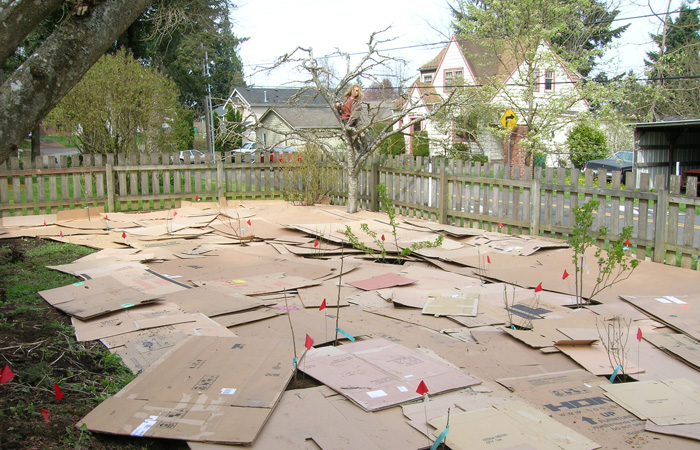When we decided to move to the country, we became interested in the gardening philosophy of permaculture. Permaculture is focused on creating a system were living and nonliving parts of the garden work together to create a thriving mini-ecosystem. We were focused on improving the quality of our soil and reducing the amount of weeds. If you have healthy soil that has a fungi/bacteria ratio that favors the type of plants you want to grow, your desired plants will thrive and the weeds will fail.
One particularly good permaculture strategy that works well in an area where there is grass or weeds is “lasagna mulching.” Anyone who has tried, knows that tilling up grass can be very difficult and requires many passes of the tiller and lots of sweat and toil. A simpler way is to cover the grass with something thick, opaque, and organic, that will prevent the grass from growing through. This is termed lasagna mulching because you are making a lasagna with organic materials: the cardboard layers are the noodles and the compost, soil, and straw layers are the sauce. The grass is killed by lack of sunlight and over the years, as this organic mix breaks-down, nutrients are released into the soil.
We used lasagna mulching over a very large portion of our front yard when planting our orchard, topping the organic layers with wood mulch for a clean look. The wood mulch mimics a forest-like environment because forests would naturally have old trees rotting on their floors, the decomposing wood creates a fungi-rich soil where trees thrive.
The cardboard did a fantastic job keeping the weeds out of the orchard for 2 years. When the cardboard began to break down and the weeds returned, we turned to permaculture for other ideas. We decided to plant clover into the decaying cardboard/straw/wood mulch as a cover crop. Clover is an excellent candidate because it doesn’t grow very high, returns year after year, and fixes nitrogen to provide nutrients to the orchard. The clover did a good job outcompeting the weeds for the first year. The orchard took on a “rustic” look, lush and green. The following year the clover returned but went to seed quickly and looked quite sparse for most of the growing season. This sparseness resulted in the return of the weeds. The third season the orchard looked a little too barbaric even for us. We decided to return to the cardboard and wood mulch and now the garden looks pristine again!
When growing a garden or orchard, weeds are ever-present. Learning from permaculture guidelines, we tried two different techniques to control weeds. Creating “lasagna” from cardboard, compost and mulch added nutrients to our soil and kept the weeds at bay for two years. Using clover as a cover-crop also out-competed the weeds for about 2 years. Although neither technique reduced weeding to zero, both provided relief from weeds for about 2 years and increased the nutrients in the soil. Perhaps cycling between the two techniques every 2 years will afford the best soil health and weed control. As one of the permaculture principles states, “Observe and interact”. We learn as we go.




